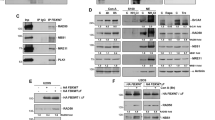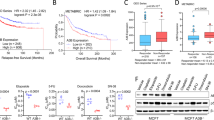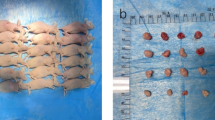Summary
Multinuclear platinum compounds were rationally designed to bind to DNA in a different manner from that of cisplatin and its mononuclear analogues. A triplatinum compound of the series (BBR 3464) was selected for preclinical development, since, in spite of its charged nature, it was very potent as cytotoxic agent and effective against cisplatin-resistant tumour cells. Anti-tumour efficacy studies were performed in a panel of human tumour xenografts refractory or poorly responsive to cisplatin. The novel platinum compound exhibited efficacy in all tested tumours and an impressive efficacy (including complete tumour regressions) was displayed in two lung carcinoma models, CaLu-3 and POCS. Surprisingly, BBR 3464 showed a superior activity against p53-mutant tumours as compared to those carrying the wild-type gene. The involvement of p53 in tumour response was investigated in an osteosarcoma cell line, SAOS, which is null for p53 and is highly sensitive to BBR 3464, and in the same cells following introduction of the wild-type p53 gene. Thus the pattern of cellular response was investigated in a panel of human tumour cells with a different p53 gene status. The results showed that the transfer of functional p53 resulted in a marked (tenfold) reduction of cellular chemosensitivity to the multinuclear platinum complex but in a moderate sensitization to cisplatin. In addition, in contrast to cisplatin, the triplatinum complex was very effective as an inducer of apoptosis in a lung carcinoma cell line carrying mutant p53. The peculiar pattern of anti-tumour activity of the triplatinum complex and its ability to induce p53-independent cell death may have relevant pharmacological implications, since p53, a critical protein involved in DNA repair and induction of apoptosis by conventional DNA-damaging agents, is defective in several human tumours. We suggest that the peculiar DNA binding properties of the triplatinum complex may contribute to the striking profile of anti-tumour efficacy. Taken together, the available information supports that anti-tumour activity of the novel compound is mediated by a mechanism different from that of conventional platinum complexes, and compounds of this series could represent a new class of promising anti-tumour agents.
Similar content being viewed by others
Article PDF
Change history
16 November 2011
This paper was modified 12 months after initial publication to switch to Creative Commons licence terms, as noted at publication
References
Brachmann, R. K., Vidal, M. & Boeke, J. D. (1996). Dominant-negative p53 mutations selected in yeast hit cancer hot spots. Proc Natl Acad Sci USA 93: 4091–4095.
Caserini, C., Pratesi, G., Tortoreto, M., Bedogné, B., Carenini, N., Supino, R., Perego, P., Righetti, S. C. & Zunino, F. (1997). Apoptosis as a determinant of tumour sensitivity to topotecan in human ovarian tumours: preclinical in vitro/in vivo studies. Clin Cancer Res 3: 955–961.
Chu, G. (1994). Cellular responses to cisplatin. J Biol Chem 269: 787–790.
Crul, M., Schellens, J. H. M., Beijnen, J. H. & Maliepaard, M. (1997). Cisplatin resistance and DNA repair. Cancer Treat Rev 23: 341–366.
Eastman, A. (1987). The information, isolation and characterization of DNA adducts produced by anticancer platinum complexes. Pharmacol Ther 34: 155–166.
Farrell, N. (1993). Nonclassical platinum antitumour agents: perspective for design and development of new drugs complementary to cisplatin. Cancer Invest 11: 578–589.
Farrell, N. (1995a). DNA binding and chemistry of dinuclear platinum complexes. Comments in Inorganic Chemistry 16: 373–389.
Farrell, N. (1996). DNA binding of dinuclear platinum complexes. In Advances in DNA Sequence Specific Agents, Hurley LH, Chaires JB JAI Press Inc 187–216.
Farrell, N., Appleton, T. G., Qu, Y., Roberts, J. D., Soares Fontes, A. P., Skov, K. A., Wu, P. & Zou, Y. (1995b). Effects of geometric isomerism and ligand substitution in bifunctional dinuclear platinum complexes on binding properties and conformational changes in DNA. Biochemistry 34: 15480–15487.
Farrell, N., Qu, Y., Kasparkova, J., Brabec, V., Valsecchi, M., Menta, E., Di Domenico, R., Conti, M., Da Re, G., Lotto, A. & Spinelli, S. (1997). Chemical studies and DNA binding of charged polynuclear platinum complexes. Proc Am Ass Cancer Res 38: 310
Fink, D., Nebel, S., Aebi, S., Zheng, H., Cenni, B., Nehmé, A., Christen, R. D. & Howell, S. B. (1996). The role of DNA mismatch repair in platinum drug resistance. Cancer Res 56: 4881–4886.
Harris, C. C. (1996). Structure and function of the p53 tumour suppressor gene: clues for rational cancer therapeutic strategies. J Natl Cancer Inst 88: 1442–1455.
Hecker, D., Page, G., Lohrum, M., Weiland, S. & Scheidtmann, K. H. (1996). Complex regulation of the DNA-binding activity of p53 by phosphorylation: differential effects of individual phosphorylation sites on the interaction with different binding motifs. Oncogene 12: 953–961.
Hickman, J. A. (1996). Apoptosis and chemotherapy resistance. Eur J Cancer 32A: 921–926.
Johnson, A., Qu, Y., Van Houten, B. & Farrell, N. (1992). B→Z-DNA conformational changes induced by a family of bis(platinum) complexes. Nucleic Acids Res 20: 1697–1703.
Kastan, M. B., Canman, C. E. & Leonard, C. J. (1995). P53, cell cycle and apoptosis implications for cancer. Cancer Met Rev 14: 3–15.
Kelland, L. R. (1994). The molecular basis of cisplatin sensitivity/resistance. Eur J Cancer 30A: 725–727.
Lowe, S. W., Bodis, S., McClatchey, A., Remington, L., Ruley, H. E., Fisher, D. E., Housman, D. E. & Jacks, T. (1994). p53 status and the efficacy of cancer therapy in vivo. Science 266: 807–810.
O’Connor, P. M., Jackman, J., Bae, I., Myers, T. G., Fan, S., Mutoh, M., Scudiero, D. A., Monks, A., Sausville, E. A., Weinstein, J. N., Friend, S., Fornace, A. J. & Kohn, K. W. (1997). Characterization of the p53 tumour suppressor pathway in cell lines of the National Cancer Institute Anticancer Drug Screen and correlations with the growth-inhibitory potency of 123 anticancer agents. Cancer Res 57: 4285–4300.
Perego, P., Giarola, M., Righetti, S. C., Supino, R., Caserini, C., Delia, D., Pierotti, M. A., Miyashita, T., Reed, J. C. & Zunino, F. (1996). Association between cisplatin resistance and mutation of p53 gene and reduced bax expression in ovarian carcinoma cell systems. Cancer Res 56: 556–562.
Perego, P., Righetti, S. C., Supino, R., Delia, D., Caserini, C., Carenini, N., Bedogne’, B., Broome, E., Krajewski, S., Reed, J. C. & Zunino, F. (1997). Role of apoptosis and apoptosis-related proteins in the cisplatin-resistant phenotype of human tumor cell lines. Apoptosis 2: 540–548.
Perego, P., Caserini, C., Gatti, L., Carenini, N., Romanelli, S., Supino, R., Colangelo, D., Viano, I., Leone, R., Spinelli, S., Pezzoni, G., Manzotti, C., Farrell, N. & Zunino, F. (1999). A novel trinuclear platinum complex overcomes cisplatin resistance in an osteosarcoma cell system. Mol. Pharmacol 5: 528–534.
Righetti, S. C., Della Torre, G., Pilotti, S., Menard, S., Ottone, F., Colnaghi, M. I., Pierotti, M. A., Lavarino, C., Cornarotti, M., Oriana, S., Bohm, S., Bresciani, G. L., Spatti, G. & Zunino, F. (1996). A comparative study of p53 gene mutations, protein accumulation, and response to cisplatin-based chemotherapy in advanced ovarian carcinoma. Cancer Res 56: 689–693.
Rolley, N., Butcher, S. & Milner, J. (1995). Specific DNA binding by different classes of human p53 mutants. Oncogene 11: 763–770.
Supino, R., Righetti, S. C., Magnani, I., Bottiroli, G. & Prosperi, E. (1996). Modulation and cell cycle distribution of mutant p53 protein in a human small-cell lung carcinoma cell line after exposure to cytotoxic agents. Cell Pharmacol 3: 253–260.
Vogelstein, B. & Kinzler, K. W. (1994). X-rays strike p53 again. Nature 370: 174–175.
Wang, X. W., Yeh, H., Schaeffer, L., Roy, R., Moncollin, V., Egly, J-M, Wang, Z., Freidberg, E. C., Evans, M. K., Taff, B. G., Bohr, V. A., Weeda, G., Hoeijmakers, J. H. J., Forrester, K. & Harris, C. C. (1995). p53 modulation of TFIIH-associated nucleotide excision repair activity. Nat Genet 10: 188–195.
Workman, P., Balmain, A., Hickman, J. A., McNally, N. J., Mitchison, N. A., Pierrepoint, C. G., Raymond, R., Rowlatt, C., Stephens, T. C. & Wallace, J. (1988). UKCCCR guidelines for the welfare of animals in experimental neoplasia. Br J Cancer 58: 109–113.
Wu, P., Kharatishvili, M. & Farrell, N. (1996). A circular dichroism study of ethidium bromide binding to Z-DNA induced by dinuclear platinum complexes. J Inorg Biochem 63: 9–16.
Zunino, F., Perego, P., Pilotti, S., Pratesi, G., Supino, R. & Arcamone, F. (1997). Role of apoptotic response in cellular resistance to cytotoxic agents. Pharmacol Ther 76: 177–185.
Author information
Authors and Affiliations
Rights and permissions
From twelve months after its original publication, this work is licensed under the Creative Commons Attribution-NonCommercial-Share Alike 3.0 Unported License. To view a copy of this license, visit http://creativecommons.org/licenses/by-nc-sa/3.0/
About this article
Cite this article
Pratesi, G., Perego, P., Polizzi, D. et al. A novel charged trinuclear platinum complex effective against cisplatin-resistant tumours: hypersensitivity of p53-mutant human tumour xenografts. Br J Cancer 80, 1912–1919 (1999). https://doi.org/10.1038/sj.bjc.6690620
Received:
Revised:
Accepted:
Published:
Issue date:
DOI: https://doi.org/10.1038/sj.bjc.6690620
Keywords
This article is cited by
-
Inhibition of nuclear factor kappaB proteins-platinated DNA interactions correlates with cytotoxic effectiveness of the platinum complexes
Scientific Reports (2016)
-
Increased toxicity of a trinuclear Pt-compound in a human squamous carcinoma cell line by polyamine depletion
Cancer Cell International (2012)
-
Thermodynamic stability and energetics of DNA duplexes containing major intrastrand cross-links of second-generation antitumor dinuclear PtII complexes
JBIC Journal of Biological Inorganic Chemistry (2012)
-
Polyamines: fundamental characters in chemistry and biology
Amino Acids (2010)
-
Crystal structure and infrared analysis of a new trinuclear platinum(II) complex with L-cysteine
Journal of Chemical Crystallography (2007)



